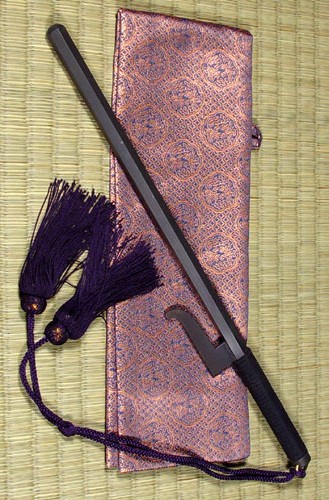
I - J
I
| I | Stomach (organ function meridian, ST) |
| Iai Goshi | Relationship Hip, lowered, stable position; with one leg up, one tucked in Kiza |
| Iai Hiza | Kneeling on one calf |
| Ibuki | A breathing method |
| Ichi | One |
| Ichimonji | In the figure of One, a straight line |
| Ido | Movement |
| Idori | Techniques practiced from Seiza |
| Iemoto | House Founder, leader of a style (classical term, now Soke is more common). |
| Igen | Dignity or majesty of demeanor |
| Iie | No |
| Ifu | Dojo tradition |
| Ikki-ni | In one breath; instantly |
| Ikkyo | First
principle in Aikido Oshi Taoshi, Ude Osae, Ippon
Dori
|
| Ikkyu | First hill, the last rank before Shodan (the first black belt rank) |
| Ima | Now |
| In | The negative, yielding, soft, dark aspects of nature (Chinese: yin). |
| Inasu | To shift the body off the line of attack |
| In Ibuki | Internal (quiet) breathing |
| Inko | Throat |
| In no Te | Yin hand, defensive, yielding etc. |
| Inyo Shintai | Yin/Yang body motions, moving forward and back. |
| Ippon | One point |
| Ippon Dori | One point taking, the Daito Ryu jujutsu technique, Ude Osae, Aikido's Ikkyo |
| Ippon-ken | One point fist, a fist with a raised knuckle |
| Irimi | Entering body |
| Irimi Nage | Entering throw, known in some Aikido circles as the "20 year technique" |
| Ishin | One mind |
| Isshin Denshin | One-mind telegraph, telepathy, transferring or receiving thoughts |
J
| Jigai | Woman's ritual suicide method, slicing both arteries of the neck. |
| Jigoku | Hell |
| Jigoku Iri | (To)
enter hell |
| Jigoku Otoshi | Hell Drop |
| Jigotai | Defensive posture, a deep stance, similar to Chinese 'horse stance' |
| Jiki Deshi | A Direct Student, one who studies with the headmaster of a style |
| Jiko no Kansei | Strive for perfection, a maxim of Kodokan Judo |
| Jin | Person; human
|
| Jinchu | Pressure point on the upper lip, below the nose |
| Jinkai-kyusho | Vital points on the human body |
| Jintai | The body |
| Jin(zo) | Kidneys (KiD or KD) |
| Jisha | (An) attendant, usually
one who travels with a
VIP or teacher to act as assistant
|
| Jiten | Dictionary |
| Jitsu | Deficient or lacking, (can also mean fake) |
| Jiyu | Free, unencumbered |
| Jo | Stick, a short staff usually between 49" and 54" |
| Jo | Principle (not a word, cannot be used on its own, same as kajo) |
| Jo | Upper, high |
| Jodan | High-level |
| Jodan Tsuki | Upper-level thrust (head high punch) |
| Jodan no Kamae | Upper level, sword above head. Usually Hidari Jodan, left foot forward |
| Jojutsu | Stick Art, techniques and tactics using the jo |
| Joseki ni rei | Bow to the high section of the Dojo |
| Joshu | Assistant (usually instructor) |
| Jotori | Jo Taking, techniques for defending against a Jo wielder |
| Ju | Pliant, supple, yielding, often mistranslated as 'soft' |
| Ju | Ten |
| Juban | An under kimono worn |
| Judan | Tenth-level, the highest rank achievable in modern budo |
| Judo | Supple or pliant way, the teachings of Jigoro Kano |
| Jugyo | Instruction (lessons, teachings) |
| Juichidan | Eleventh-level, a rank used by Kodokan Judo's founder, Jigoro Kano |
| Juizo | The kidney area
|
| Juji | "10" form; the kanji is a cruciform (+) |
| Juji Garami | Figure "10" entangling, Uke's arms crossed, elbows locked |
| Jujika | Figure "10," ashi sabaki with crossed feet |
| Jujutsu | Supple or Pliant Art, generic term for unarmed Japanese martial arts. |
| Juku | Private school |
| Juku Gashira | School Mask, the senior student of a ryu, one who receives the gokui. |
| Jukuren | Skills |
| Jukyu | Tenth hill, tenth level before shodan |
| Junchu | Atemi point on the upper lip |
| Jutsu | Art, skill or tactic |
| Jutte | Ten Hands, an anti-sword truncheon used by police in the Edo period; almost always employed in conjunction with other people (wielding sode-garami or other such weapons) |
Visitors are
welcome, by appointment, as are beginners and guests. To
schedule an
interview,
please
E-mail or
call us 617.501.3446.

